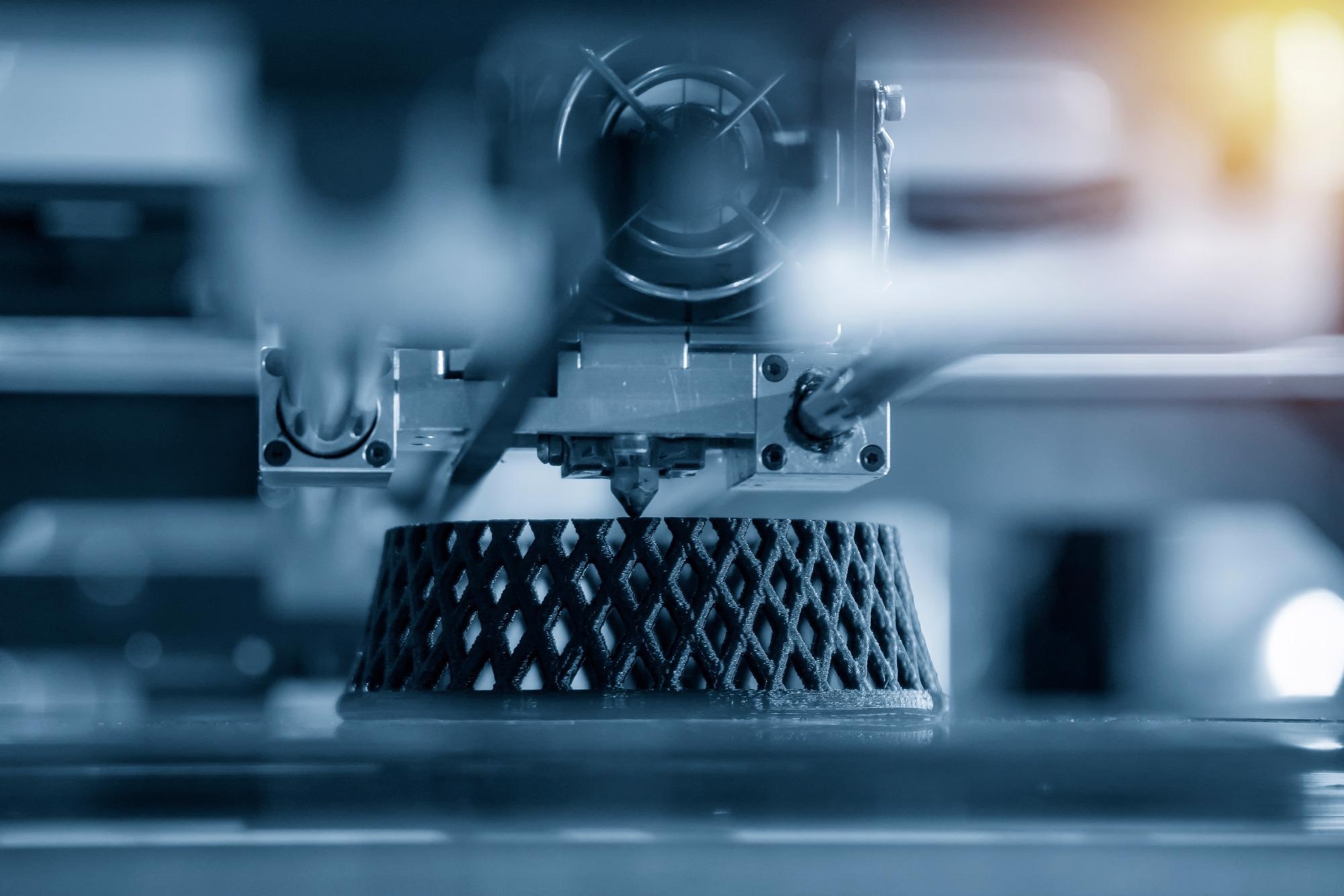
Image Credit: PixelB/Shutterstock.com
Heralded as a key technology to improve the environmental credentials and sustainability of manufacturing, 3D printing (or additive manufacturing) certainly meets the main criteria for sustainability – reduce, reuse, and recycle. But upon closer inspection, how viable is it as an alternative to current manufacturing processes?
Why 3D Printing?
Using computer-aided design, 3D printing builds an item up layer by layer in a very precise fashion. Initially, plastics and metal powders were used as the feedstock for the process, but now resins, carbon fibers, and even graphite and graphene are widely used too.
The technique has many advantages over traditional manufacturing methods: it enables rapid prototyping, increases efficiency, and permits the manufacture of unique items. It can also reduce production costs and carbon dioxide emissions from the process, and lower the energy consumption over the lifecycle of a product.
For example, a Michigan Technological University study found 41-64% less energy was used to 3D print an item than manufacture it overseas and ship to the US; the result of fewer materials required and a reduced need for shipping.
This article explores 3D printing in the context of the 3 Rs – reduce, reuse, and recycle to determine just how sustainable the method is.
Reducing Waste by 3D Printing
Traditional manufacturing methods can be wasteful, and consume large amounts of energy and raw materials. Rather than sculpting an item from a huge piece of metal or plastic, 3D printing precisely fabricates the item layer by layer. As a result, there is considerably less scrap waste – between 70% and 90% compared to some traditional manufacturing methods such as CNC manufacturing or injection molding.
Much of the design process is carried out on computers, and with the advent of improved computer simulations, it is possible to identify where parts can be improved. It is also possible to identify where they might fail, meaning fewer prototypes are required and less waste generated.
It can also streamline the manufacturing process, leading to efficiency gains and often fewer parts. This is seen in 3D-printed electronics where the electrical and mechanical functionalities can be combined, and therefore the number of parts reduced. Not only does this mean fewer parts that need to be designed or manufactured, but it can also result in better performing parts with improved durability.
How Does 3D Printing Reduce Emissions During Manufacturing
A reduction in carbon dioxide emissions is also possible. Firstly, because printing is often a more efficient process, less energy is required to create the resulting products, especially when merging parts. Secondly, part consolidation can create long-term fuel savings and fewer emissions from cars and planes where they are used.
Because the design process is primarily conducted on computers, the resulting blueprints can be shared digitally and parts printed nearby, onsite, or even in people’s homes. This decreases the need for the extensive transport required of conventional mass manufacturing, where not only the final products but the raw materials need shipping over long distances, reducing carbon dioxide emissions.
Reusing Raw Materials and Faulty Products in Additive Manufacturing
During any manufacturing process, many prototypes and iterations are made before the optimal product design is found, resulting in unwanted and discarded items – items created from important raw materials that can be reused. This also applies to faulty products or those made by mistake.
There is the misconception that metals cannot be reused in their powder form but if recycled and reused properly, there is little-to-no effect on the mechanical properties of the end product.
Recycling Single-Use Products
Companies and consumers are encouraged to use more sustainable raw materials. Those utilizing 3D printing can choose from a wide range of sustainable, recyclable and environmental feedstocks. Some 3D printers recycle post-consumer single-use plastics such as water bottles and convert them into a raw material it can use, while others use natural materials such as spent coffee grounds, algae, and cellulose.
Potential Concerns of 3D Printing
Although 3D printing allows for rapid prototyping and the quick and easy production of novel items, it still contributes to the increasing number of readily available consumer products that will likely make their way into landfills.
Even though the process is less wasteful and closely adheres to the 3 Rs than other manufacturing methods, it is not wasteless; there is still post-processing waste and failed parts to consider. 3D-printed items often require supports to prevent deformation during printing, and how to dispose of these must be taken into consideration when determining how sustainable the process is.
The Future of 3D Printing in Manufacturing
It is likely that manufacturing in the future will be a blend of traditional methods and 3D printing. The latter tends to be more resource-saving and enables more efficient and novel designs that contribute to lower manufacturing requirements. It is also greener, cleaner, and more sustainable than traditional manufacturing techniques; even so, there is room for improvement.
References and Further Reading
Reichental A. (2020) When it comes to 3D printing, how much sustainability is enough? tct mag [Online] https://www.tctmagazine.com/blogs/guest-column/3d-printing-how-much-sustainability-is-enough (Accessed 7 January 2021).
AMFG (2020) How Sustainable is Industrial 3D Printing? AMFG [Online] https://amfg.ai/2020/03/10/how-sustainable-is-industrial-3d-printing/ (Accessed 7 January 2021).
Folk E, (2019) How Sustainable Is 3D Printing? 3DPrint.com [Online] https://3dprint.com/239063/dhow-sustainable-is-3d-printing/ (Accessed 8 January 2021).
Disclaimer: The views expressed here are those of the author expressed in their private capacity and do not necessarily represent the views of AZoM.com Limited T/A AZoNetwork the owner and operator of this website. This disclaimer forms part of the Terms and conditions of use of this website.